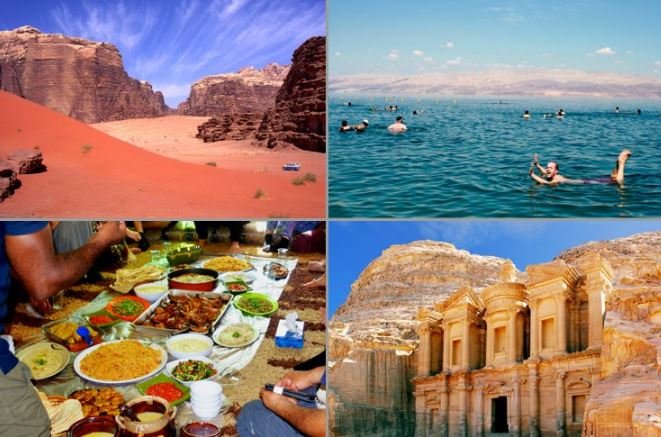Jordan, a captivating country in the heart of the Middle East, is a land rich in history, culture, and natural beauty. From ancient cities carved into rock to stunning desert landscapes and the shores of the Dead Sea, Jordan offers a diverse range of experiences for every traveler. Here are the top 5 places to visit in Jordan.
1. Petra
Petra, often referred to as the “Rose City” due to the pink sandstone cliffs that surround it, is an archaeological wonder and one of the New Seven Wonders of the World. This ancient Nabatean city, hidden away in the mountains, was once a thriving trade hub. Visitors enter through the narrow gorge known as the Siq, which opens up to reveal the iconic Treasury (Al-Khazneh). Other significant sites include the Monastery (Ad-Deir), the Royal Tombs, and the Roman Theater. Petra’s intricate rock-cut architecture and its historical significance make it an unforgettable destination.
Also Read: Top places to see in Jordon
2. Wadi Rum
Wadi Rum, also known as the Valley of the Moon, is a dramatic desert landscape of towering sandstone and granite rock formations. This protected area is famous for its stunning natural beauty, with vast, empty spaces that offer a sense of serenity and adventure. Visitors can explore Wadi Rum by jeep tours, camel rides, or even hot air balloon rides. The desert is also home to Bedouin communities, and spending a night in a Bedouin camp under the starry sky is an experience not to be missed.
3. Dead Sea
The Dead Sea, the lowest point on Earth at over 400 meters below sea level, is renowned for its incredibly salty water and mineral-rich mud. Floating effortlessly in the buoyant waters of the Dead Sea is a unique experience, and many visitors also take advantage of the therapeutic properties of the mud. The surrounding area offers luxury resorts and spas, making it a perfect place for relaxation and rejuvenation.
4. Amman
The capital city of Amman is a vibrant blend of ancient history and modernity. The city is built on a series of hills and is known for its bustling markets, lively cafes, and historical sites. Key attractions include the Citadel, which offers panoramic views of the city and contains ruins from various periods, including the Roman Temple of Hercules and the Umayyad Palace. The Roman Theater, a well-preserved ancient amphitheater, is another must-see. Amman’s diverse cultural scene, with its museums, galleries, and festivals, provides a deep dive into Jordanian life.
5. Jerash
Jerash, located north of Amman, is home to one of the best-preserved Roman provincial towns in the world. Known as the “Pompeii of the East,” Jerash boasts an impressive collection of Greco-Roman ruins, including colonnaded streets, temples, theaters, and plazas. The city comes to life during the Jerash Festival of Culture and Arts, an annual event featuring performances, concerts, and exhibitions that celebrate Jordanian and international culture.
Also Read: Most Beautiful Places in the World
Conclusion
Jordan is a country that offers a rich tapestry of experiences, from exploring ancient ruins and desert landscapes to enjoying the vibrant culture of its capital city. Whether you’re a history enthusiast, an adventure seeker, or simply looking for a unique travel experience, these top 5 places to visit in Jordan are sure to leave you with unforgettable memories.
Click here for top trending blogs at www.thesimplesource.com
Frequently Asked Questions (FAQs) About Visiting Jordan
1. Do I need a visa to visit Jordan?
- Yes, most travelers will need a visa to enter Jordan. Visas can be obtained on arrival at Queen Alia International Airport or at any border crossing (except the King Hussein/Allenby Bridge). Alternatively, you can apply for a visa in advance at a Jordanian consulate or embassy.
2. What is the best time to visit Jordan?
- The best time to visit Jordan is during the spring (March to May) and fall (September to November) when the weather is mild and pleasant. Summers can be extremely hot, especially in the desert regions, while winters can be cold, particularly in the higher elevations.
3. Is Jordan safe for tourists?
- Yes, Jordan is considered one of the safest countries in the Middle East for tourists. The country has a stable political environment and a strong security presence. However, like any destination, it is advisable to stay informed about current events and follow local advice and guidelines.
4. What currency is used in Jordan, and can I use credit cards?
- The currency used in Jordan is the Jordanian Dinar (JOD). Credit cards are widely accepted in hotels, restaurants, and larger shops in major cities. However, it is advisable to carry some cash for smaller establishments and when traveling to more remote areas.
5. What language is spoken in Jordan?
- The official language of Jordan is Arabic. English is widely spoken, especially in tourist areas, hotels, and businesses. Signage in tourist areas is often bilingual (Arabic and English).
6. What should I wear when visiting Jordan?
- Jordan is a predominantly Muslim country, and it is respectful to dress modestly. For women, this means covering shoulders, cleavage, and knees. Men should avoid wearing shorts in urban areas. In tourist areas like Petra and Wadi Rum, dress codes are more relaxed, but it is still advisable to dress modestly.
7. Are there any cultural customs I should be aware of?
- Yes, Jordanians are known for their hospitality, and it’s important to reciprocate with polite and respectful behavior. When entering someone’s home, it’s customary to remove your shoes. Avoid public displays of affection, and be mindful of prayer times and religious practices.
8. How do I get around in Jordan?
- Jordan has a good network of public transportation, including buses and taxis. For more convenience, especially when visiting remote areas or multiple sites in one day, renting a car or hiring a private driver is recommended. There are also organized tours available for major tourist attractions.
9. What are the top foods to try in Jordan?
- Jordanian cuisine is delicious and diverse. Must-try dishes include Mansaf (the national dish made of lamb, rice, and fermented yogurt sauce), Falafel, Hummus, Maqluba (a rice and vegetable dish), and Kanafeh (a sweet cheese pastry). Street food like Shawarma and fresh juices are also popular.
10. Can I drink tap water in Jordan?
- It is advisable to drink bottled or filtered water in Jordan. While tap water is generally safe for bathing and brushing teeth, it is recommended to use bottled water for drinking to avoid any potential stomach issues.
11. What is the tipping etiquette in Jordan?
- Tipping is customary in Jordan. In restaurants, a tip of 10-15% of the bill is typical if a service charge has not already been included. For hotel staff, a small tip for services such as carrying luggage or cleaning the room is appreciated. Tipping tour guides and drivers is also customary.
12. Are there any health precautions I should take before traveling to Jordan?
- It’s advisable to check with your healthcare provider for any recommended vaccinations before traveling to Jordan. Common vaccinations include Hepatitis A, Hepatitis B, Typhoid, and routine vaccinations. It’s also wise to carry a basic medical kit for any minor health issues.





